Two legendary crime reporters sit down at a notorious pub. The chat quickly turned to Roger Rogerson
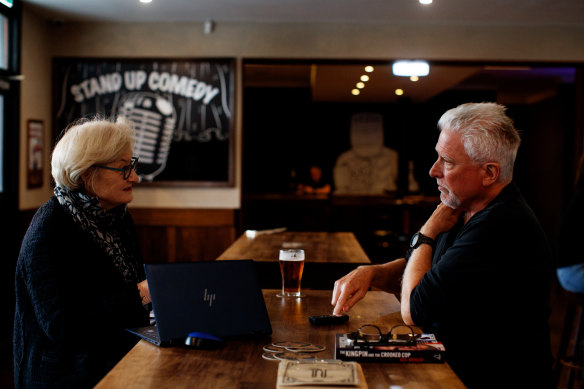
Kate McClymont and author Neil Mercer talk crime at the Iron Duke Hotel.Credit: Nikki Short
Wearing a black puffer jacket and black jeans, sporting silvering hair and beard, legendary crime reporter Neil Mercer already has a beer at hand and is chatting affably to the staff at the Iron Duke Hotel as I arrive.
It’s a winter’s afternoon and there are a few young-professional types enjoying lunch, probably oblivious to the Iron Duke’s former reputation as one of the most “notorious” pubs in the country.
This is not Mercer’s first, second or even third visit to the once-renowned gangsters’ hangout where rival rogues’ toes were reputedly separated from their feet in the cellar. “It’s about my tenth visit,” he says with a laugh.
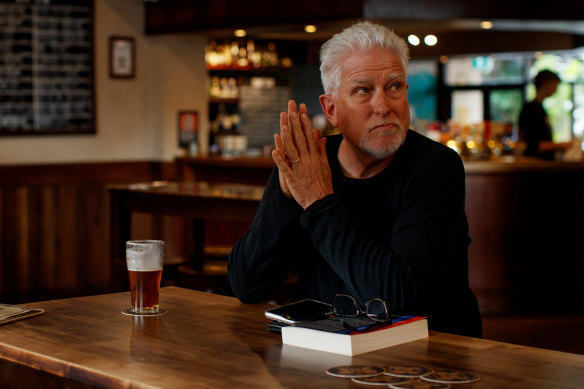
Journalist and author Neil Mercer’s career trajectory was changed by the death of drug dealer Warren Lanfranchi.Credit: Nikki Short
The last time was to catch up with “an old villain” and the time before that was to film the late disgraced detective Roger Rogerson in the pub’s sinister crypt.
Some of the real-life action in Mercer’s new book, The Kingpin and the Crooked Cop, featuring the brutal underworld crime figure Arthur “Neddy” Smith and his pal, the murderous detective Rogerson, takes place at the scene of our luncheon rendezvous, on the corner of McEvoy Street and Botany Road, Alexandria.
Mercer recounts the morning of April 2, 1986, when Smith crawled into the Iron Duke after an attempt to murder him had failed. The crime boss was walking along McEvoy Street when a Holden Kingswood crossed to the wrong side of the road and onto the pavement, mowing him down. The car then tried to reverse over him.
On hand to offer Smith sanctuary was the pub’s new publican, Billy Duff, whose change of career came from being booted from the police force earlier that year because of his improper association with criminals, including the very same injured crook bleeding before him on the threshold of the Iron Duke.
Coincidentally, the same day of the murder attempt on Smith, Duff’s good mate Rogerson was charged with misconduct for improperly associating with none other than one Neddy Smith. A week later he too was out of the police force.
As we sit at a bar table, Mercer points out where controversial broadcaster Alan Jones did the honours by launching Rogerson’s own book The Dark Side in October 2009.
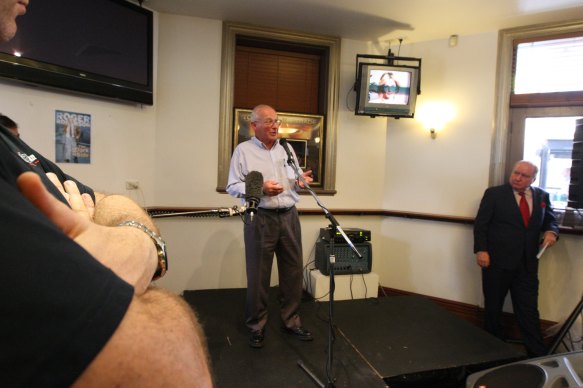
Alan Jones listens to Roger Rogerson at the launch of Rogerson’s book at the Iron Duke in 2009.Credit: Peter Rae
“When Jones said, ‘We need more police like Roger Rogerson,’ there were all these old cops and crooks, including Karl Bonnette [once described as the godfather of the Sydney underworld]. They were just looking at each other sideways and going, f---,” says Mercer.
Jones also urged the audience not to believe everything they read or heard about the state’s most notoriously corrupt detective.
By the time of his book launch, Rogerson had been twice jailed for perverting the course of justice and for lying to the Police Integrity Commission. He was suspected of murdering drug dealer Warren Lanfranchi and, miraculously, he’d been acquitted of conspiring to murder undercover cop Michael Drury.
In the years following, Rogerson engaged in some of his unique “old-style” policing which included ripping off a drug dealing uni student and murdering him. Rogerson, who was jailed for life, died in January.
Mercer’s rise to becoming a legendary crime reporter was very much tied to his reporting on Rogerson’s slither into infamy, but the tale is momentarily interrupted by the arrival of his impressive chicken parmigiana. “Classic! Wow, that look’s great,” extolls Mercer who offers me some of his generous accompaniment of chips before my own miso salmon, on a bed of cauliflower arrives.
Mercer, who effortlessly demolishes his “parmie”, recounts his first encounter with Rogerson. It’s December 1982 and Mercer is working for The Sydney Morning Herald when he lands a much sought-after interview with Rogerson.
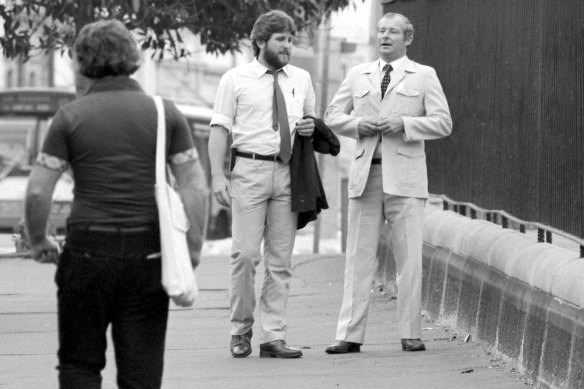
Mercer has never forgotten Roger Rogerson looking him straight in the eye as the bent cop denied being involved in criminal activities. Credit: Peter Morris
“I regret it, of course I do,” Rogerson told Mercer of the Lanfranchi shooting the previous year. “I regret being put in a situation where a man’s life is taken. I believe I acted in good faith, and that if I had not shot him, he would have shot me”.
When it was published, the story was accompanied by Peter Morris’ famous photograph of Rogerson and Mercer as they walk to a coffee shop in Oxford Street, Darlinghurst, where Rogerson was then stationed.
Rogerson, hands behind his back, is wearing a beige safari suit, while Mercer, shirt sleeves rolled up, pen in his shirt pocket and tie askew. While you can’t tell from the photo if Rogerson is armed, I ask Mercer about what he has clipped to his belt.
“The latest technology: a pager!” he replied, adding that he largely ignored it because its beep meant that the chief of staff was trying to get hold of him.
The unwavering intensity of Rogerson’s stare has stayed with Mercer all these years. His gaze never wavered even as he coolly denied the rumours of his involvement in corruption, heroin dealing and skimming the proceeds of armed robberies.
As Mercer looks back over his award-winning career as an investigative and crime reporter on both screen and in print, he notes, “The only outfit I haven’t worked for is Ten.”
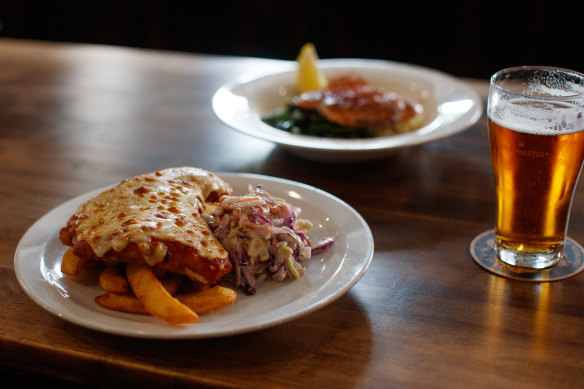
The chicken parmigiana and the miso salmon at the Iron Duke Hotel.Credit: Nikki Short
Our paths have crossed continuously over the years, and at one stage – back in 1988 – we both worked at the ABC’s Four Corners. I was a researcher when the charismatic Mercer won a Walkley Award for his program on the convicted Whiskey Au Go Go killer James Finch.
“Nepotism is vastly underrated,” hoots Mercer as he recounts his start in journalism at the age of 17. Born in Perth in 1954, Mercer went straight from school to a cadetship at The West (The West Australian).
It helped that his grandfather was a journalist on The Farmers Weekly, his older brother was a journalist at The West, while his uncle also worked there in distribution.
After a stint doing the shipping and weather reports, Mercer was dispatched to The South Western Times in Bunbury, two hours’ drive south of Perth. At the local paper, which came out twice a week, Mercer was rather improbably appointed the paper’s racing and trotting reporter.
“I didn’t know one end of a horse from another: the perfect man for the job,” he laughs.
He recalls meeting the president of the district trotting club who told him he had a trotter running in a forthcoming race and that Mercer should “get on it”.
Mercer, who was earning $40 a week, lashed out, putting on a dollar. The nag in question romped home at 15 to one. When told of Mercer’s modest outlay, the president said he would have lent him “a tenner” for the bet.
Back in the office, Mercer’s eyes widened as “the editor enlightened me about running dead, pulling up horses and race fixing”. Mercer thinks the president later ended up in jail. “There’s no doubt, looking back, the race was fixed. I just didn’t have a bloody clue,” Mercer said.
Mercer covered state parliament for The West before becoming the paper’s Melbourne correspondent, followed by a posting to Sydney, where he later joined The Sydney Morning Herald in 1975.
After a stint in the US and covering the City of Sydney council for The Daily Telegraph, in 1981, he took a job at Truth, which was co-owned and edited by veteran journalist and media commentator, Mark Day.
The paper’s advertising revenue was boosted by sex workers, said Mercer. “I remember a lot of the girls coming up the first flight of stairs and paying for their ads in cash.”
Truth had an eclectic mix of lowbrow scandals, perhaps the most famous being its front page screamer: Sneddon “Died on the job”. In 1987, the former Liberal Party leader Sir Billy Snedden died of a heart attack in a Rushcutters Bay hotel, supposedly while having sex with a mystery woman.
But along with its salacious snippets and muckraking, Truth also ran hard-hitting investigative journalism.
In June 1981, Detective Sergeant Rogerson shot dead drug dealer Warren Lanfranchi in Dangar Place, Chippendale, only a kilometre from Truth’s office, which was on the corner of Broadway and Glebe Point Road.
The editor dispatched Mercer to talk to Lanfranchi’s dad Keith. Mercer came back with a story that would change his life. Keith Lanfranchi was convinced that Rogerson had murdered his son in cold blood and that Neddy Smith had knowingly delivered his son to meet his fate.
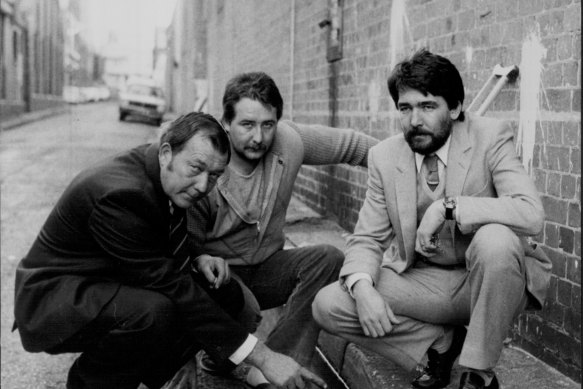
Keith Lanfranchi (left), father of Warren, with his remaining sons Howard and Darell, at the site where Warren was shot in Chippendale.Credit: Paul Mathews/Fairfax Media
Having struck a rapport with Keith Lanfranchi, Mercer found himself accompanying Keith to the Glebe morgue where his son’s body was wheeled out on a gurney. Keith wanted Neil to be a witness because he suspected the police might be trying to cover up his son Warren’s wounds. “The bullet wounds were very small,” recalled Mercer. “One went through his chest, another through his heart.”
Little was Mercer to know as he stood there in the morgue looking at the tragedy Rogerson had caused, that more than 40 years on, he would still be writing about the fallout from what became known as “High Noon in Dangar Place”.
In the process of writing his latest book, Mercer has uncovered an even darker side to Rogerson than any of us crime buffs knew.
“Keith Lanfranchi was a decent person and I felt an obligation to get to the truth on his behalf,” said Mercer.
The more Mercer looked, the more horrified he was. “So many people who crossed paths with these two men ended up dead or disappeared off the face of the earth.
“This was police corruption at its very worst and I felt compelled to get to the heart of it.”
The Kingpin and the Crooked Cop by Neil Mercer is published by Allen & Unwin.
Start the day with a summary of the day’s most important and interesting stories, analysis and insights. Sign up for our Morning Edition newsletter.